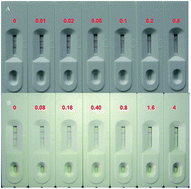Immunochromatographic strip development for ultrasensitive analysis of aflatoxin M1
Abstract
A specific monoclonal antibody against aflatoxin (AF) M1 was prepared by a duo-immunogen immunization strategy. After two immunizations of Balb/c mice with AFB1 keyhole limpet hemocyanin (KLH) conjugates and followed by five subsequent immunizations of AFM–KLH, the mice secreting antibody against AFM1 were selected for cell fusion and a 7C6-H1 cell line was obtained to produce the antibody. The 50% inhibition rate of the prepared antibody was calculated as 0.034 ± 0.002 μg L−1. The anti-AFM1 antibody was characterized with high affinity to AFM1 (1.28 × 109 mol L−1) and low cross-reactivity to related AFs (<5%). With a competitive format, an immunochromatographic strip was developed using AFB1–bovine serum albumin as the immobilized antigen and anti-AFM1 antibody labeled with gold nanoparticles as tracers. Without any sample preparation, the strip could be directly applied to detect AFM1 contamination in liquid milk. The minimum cut-off concentrations were 0.2 μg L−1 and 1.6 μg kg−1 in liquid milk and powdered milk, respectively, by assessment with the naked eye. Detection of real samples and spiked milk samples indicated the potential of this strip in routine AFM1 monitoring.


 Please wait while we load your content...
Please wait while we load your content...